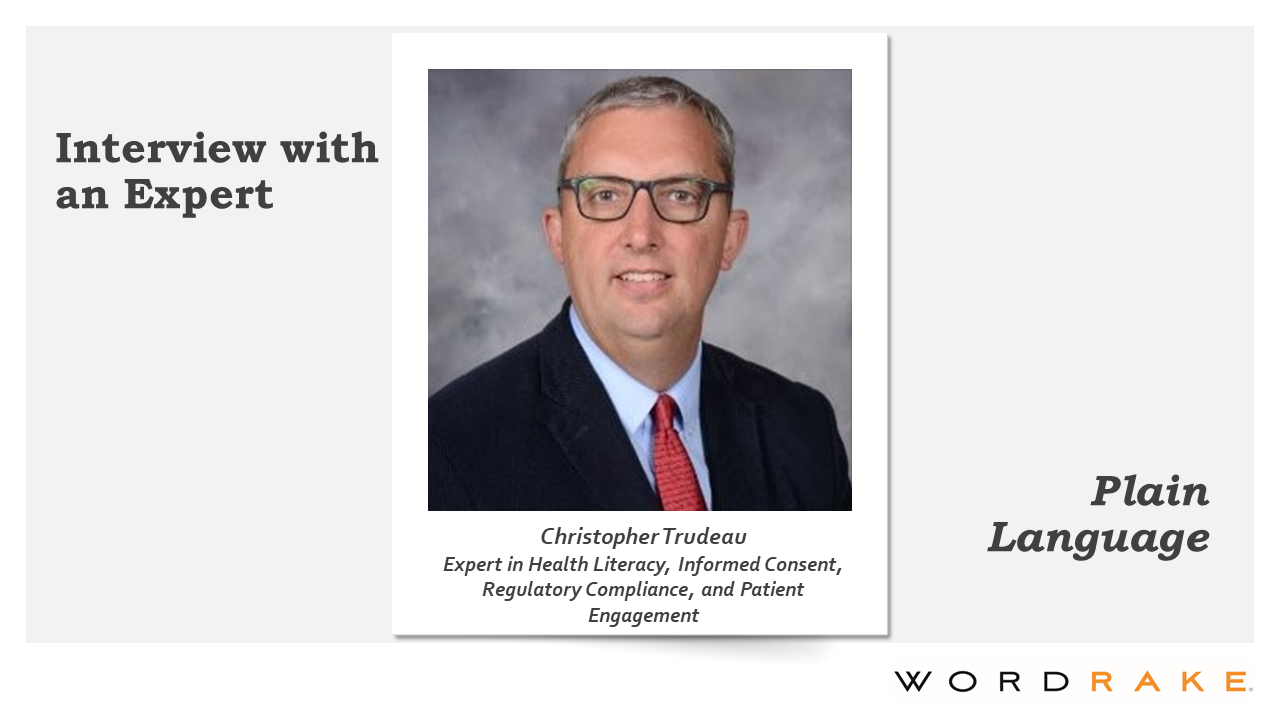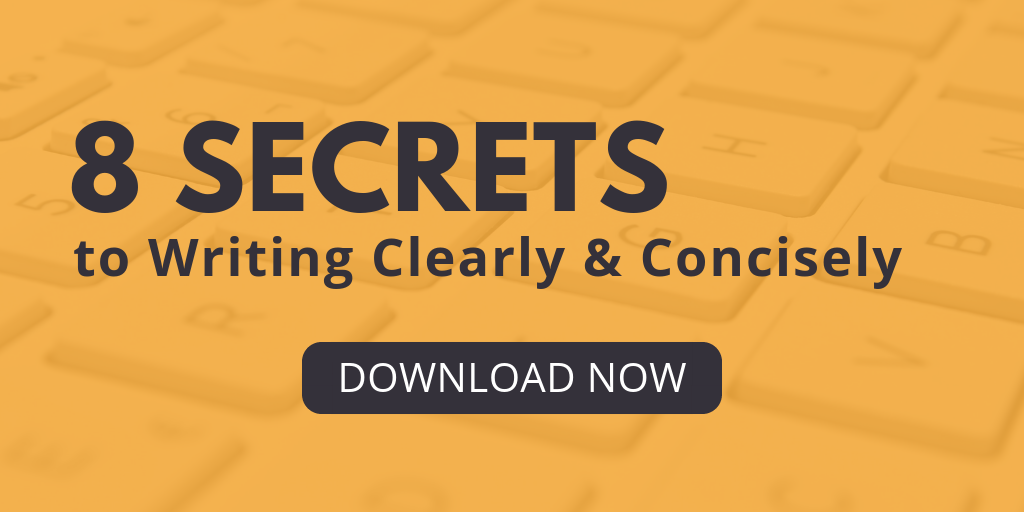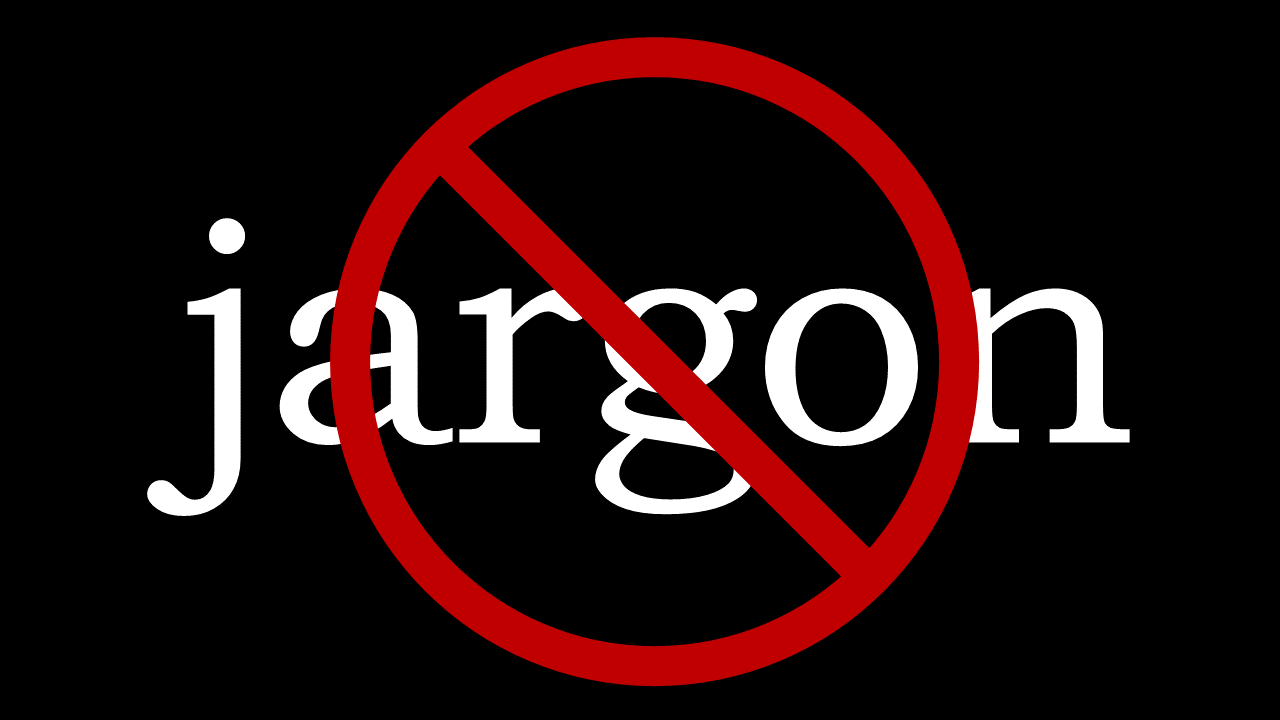Plain language helps people to find what they need, understand what they find, and have enough information to act on and meet their needs. The intersection where health and law meet seems like one of the least likely places where you’d find plain language. But Professor Christopher Trudeau is changing that.
We spoke with Chris about plain language and health literacy. In this interview, Chris explains how “every facet of modern life can be improved or enhanced by plain language” and shares what he’s learned from his research. Read on for Chris’s plain language insight.
What is your role and how is it connected to plain language?
I’ve been connected to plain language in law ever since law school, where I learned from Professor Joseph Kimble, one of the long-time leaders in the plain-language movement. So clear legal writing was ingrained in me from the moment I started developing my professional identity as a soon-to-be lawyer. After graduating, my legal writing skills helped set me apart from the other new associates at the large Michigan law firm where I worked. I was soon tasked with revising employment contracts and writing briefs that dealt with language issues, such as semantic and syntactic ambiguity and other rules of contractual or statutory interpretation.
After a few years of practice, Professor Kimble reached out to see if I’d be interested in being a visiting professor of legal writing. I jumped at the chance and have never looked back. Through that visiting professorship, I sat through an entire term of Professor Kimble’s class, quite literally learning from the master. That experience, of course, helped broaden my plain language skills, but it also helped me learn how to teach those skills to others. I’ve been doing that—both writing clear legal documents and teaching others how to write them—for the past 17 years!
But, in this field, you never stop learning and growing. In the early 2010s, I learned about the National Action Plan to Improve Health Literacy, which had just been released a year or so earlier. This immediately resonated with me, as I grew up in an underserved community and, quite literally, knew and regularly interacted with people who struggled to understand things in health, law, government, and finance. This led me to read everything I could on the subject, and I started applying my clear legal writing skills to the health world. I’ve since become the only lawyer ever to be appointed to the National Academy of Science, Engineering, and Medicine’s Roundtable on Health Literacy, and I just finished serving on the FDA’s Risk Communication Advisory Committee.
Today, I still love teaching legal writing—at the University of Arkansas, Little Rock, William H. Bowen School of Law. Yet I also focus much of my research and professional activities in the health literacy space. My focus is on creating clear public-facing legal documents that people can understand, like consent forms, advance directives, etc. To that end, I’ve been leading the Regulatory Knowledge & Support Function of the University of Arkansas for Medical Sciences’ Translational Research Institute for the past two years. In this role, I use my expertise in law and health literacy in the clinical research space, which has historically struggled with communicating information clearly and effectively to potential research participants.
What is the difference between plain language and plain English?
Plain language is the broader term as it relates to all languages, not just the English language. There are plain language movements for other languages too, like Plain Swedish, Spanish, and even Portuguese.
To be honest, I do not like either term – plain language or plain English. The term plain makes it seem like the writing is dull and boring. But as my former colleague, Professor Mark Cooney, nicely put it in this article, clear, effective writing is anything but plain or dull. Instead of plain language, I typically use clear writing.
But even the term “clear writing” makes it seem like clarity of prose is the only thing that matters, when we know that there is much more to making a document more user-friendly for readers. Despite this, since clear writing and plain language are the commonly used terms, I use them. I don’t have to like them to use them.😁
How are readability and plain language related?
Well, I think people correlate them together too often. By that, I mean that just because something scores well using a certain readability metric does not mean it is clear and easy to understand. By knowing how the formulas work (sentence length and syllables, mostly) anyone can game the system.
That said, I do think readability metrics are a good general guide to determine if your revisions are going in the right direction. For example, if the original document scores in the 12th grade range on the Flesch-Kincaid Grade Level measure and the revised document scores in the 7th grade range, you know you are making it clearer and easier to understand. But when people fret over lowering a document from an 8.3 grade level to a 7.9 to meet some arbitrary threshold, that’s when the formulas become counterproductive.
What are unexpected ways that plain language comes up in law, healthcare, and finance?
Would it be unexpected if I told you that every facet of modern life can be improved or enhanced by plain language? I don’t even consider that hyperbole (but maybe it is a little bit). Hear me out. People are not born learning language and knowing how things work. That has to be learned over time. How people invest and save for retirement, for example, can be improved (and has been improved) through plain-language efforts.
In healthcare, the COVID-19 pandemic has been the case study of all case studies for clear, health-literate messaging. No one on Earth knew about COVID-19 before December 2019—yet now, it would be hard to find any person above the age of 3 who has not had to learn about it. This shows you how clear writing impacts everyone—regardless of their level of education, socio-economic status, nationality, etc. Since the start of the COVID-19, we’ve learned a lot about how message delivery, message writing, misinformation, and clear language can impact how people and governments around the world act in response to that information.
How does plain language impact access to justice?
I purposely left out the legal industry in my response to the last question because I knew this question was coming. Here’s my message to legislatures, court systems, administrative agencies, and lawyers everywhere: Writing in traditional legalese makes life harder on people. All people. Stop doing it.
We have long known that judges and other lawyers, who can understand legalese, don’t like it because it makes it harder (or makes it take longer) for them to do their jobs. I say that because too often people think that legalese is about simplifying things for people who cannot understand legal concepts. But it’s more than that. What person wants to spend 20 minutes doing something that could take 10-15 minutes if the writer had just cared a little more about the user’s needs?
From an access-to-justice perspective, legal reformers can learn from the area of health literacy, which has done much more research into how to best deliver messages, convey them clearly, and motivate people to act. The barriers to access to justice are many, but one of the key problems is that people don’t know what (or who) is there to assist them. These programs are often mentioned in government forms, websites, etc., but they often are hard to understand or are not promoted in a way that meets people where they are. That said, legal aid organizations have gotten much better at this over the past few decades, but many government organizations have a lot of work ahead of them.
Many professions (i.e., law, medicine, finance) are gatekeepers of important information for the public. What obligations do professionals have to communicate in plain language?
Plain language is an ethical obligation for all professionals. For lawyers, poor communication and lack of communication is a frequent source of ethical violations.
And if that doesn’t motivate a lawyer, the business development angle might—clients prefer plain language. I’ve done two U.S. studies on client preferences for legal communication, and they both show that clients prefer it by a wide margin over traditional legal language.
Beyond writing with simpler words and shorter sentences, what else can professionals do to communicate better for the public’s benefit?
Actually, the most important change professionals can make is to start user-testing their consumer-facing documents. This sounds daunting, but it doesn’t have to be. Research has shown that if you even get the views of 5 other people when testing a website, document, etc., it can catch 85% of the errors users would make. It doesn’t need to be formal. Just get someone who is not you (and preferably not a lawyer) to review your document and then ask them questions about it. If they struggle, ask them how you might explain it more clearly. If you do this with 5 different people, you’ll catch most of the errors.
To be sure, I didn’t know about user-testing for many years, even though I routinely revised documents. But it wasn’t until I started user-testing for the high-stakes, public-facing forms that I really started to become an expert in what clear, effective writing means. We only know what we know—or how we think others will use things. But you don’t know until you test it. I always learn something from these sessions—even today.
What’s one piece of advice that you would offer to help a professional start using plain language?
This is a great question. People who are new to the area—or those who have just had that lightbulb moment and now understand the importance of plain language—often think it will be easy. They think it’s just about changings words. Yes, it is about that. But it’s so much more than that, which people soon learn.
The problem is that once they learn that it involves a lot more than just words, they tend to feel too daunted by what I call the “nuance of plain-language writing.” So what I often tell people starting out is to think about two things: (1) the purpose of the document and (2) the audience for the document.
Once you have defined the primary and secondary audiences of the document and you’ve clarified its purpose, it makes everything else so much easier. Just make your writing and document design align with the document’s purpose and the audience’s needs.
What’s the most convincing statistic that you can share to convince professionals to start using plain language?
I could go on and on about these. For lawyers, I’d start with my two studies I referenced above. That 80% of clients prefer clear language when given the choice. And, by the way, it’s about 80% for those studies that focus on judge’s preferences, too.
In the healthcare realm, the most alarming statistic I often us is this: a person’s literacy skills is a better predictor of a person’s health status, than age, race, or socio-economic status.
What are a few surprising areas where plain language is valued?
Plain language is actually much more valued in the healthcare world than it is in the legal world. The statistic above helps make that point more salient, but I think it is also because there are more research dollars available in health research. Empirical research in the legal profession typically isn’t funded through grants. So the research that does evolve tends to come from professors, government agencies, and others with a passion for the subject.
About Christopher Trudeau
Christopher Trudeau is a zealous advocate for plain language. He has focused much of his recent research on combating archaic, traditional language in law, health care, government, and business. He's published novel empirical research on the public’s preference for plain language—The Public Speaks: An Empirical Study of Legal Communication—in volume 14 of The Scribes Journal of Legal Writing (2012). If you want to learn more about Chris, or the methods to his plain-language madness, here’s a link to his faculty bio. Also, he’d love to connect with you on Twitter (@proftrudeau) or on LinkedIn.
Plain Language and Clear Communication Interview Series
This interview is part of a series produced in connection with WordRake’s support for the Access for All: Plain Language is a Civil Right conference. WordRake is editing software for sophisticated writers who must communicate clearly. It improves writing by simplifying and clarifying text, cutting jargon, and recommending plain English replacements. WordRake runs in Microsoft Word and Outlook, and its suggestions appear in the familiar track-changes style. You decide when to run WordRake and which edits to accept, so you get quality and speed without sacrificing control. Editing for clarity and brevity has never been easier. Try WordRake for free for 7 days.








